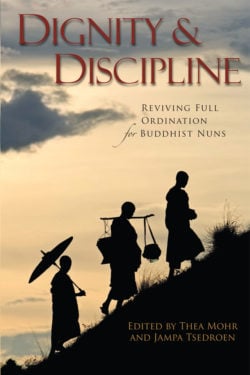Ven. Jampa Tsedroen

Bhikshuni Jampa Tsedroen (Carola Roloff) is an ordained Tibetan Buddhist nun and a lecturer and research fellow at Hamburg University specializing in nuns’ ordination and women in Buddhism.
Books, Courses & Podcasts
Dignity & Discipline
When the Buddha established his community over twenty-five centuries ago, he did so upon a foundation of radical equality among women and men. And indeed, the earliest Buddhist scriptures celebrate the teachings and inspiring influence of these path-blazing female renunciants. Nonetheless, through much of the Buddhist world, the order of nuns has disappeared or was never transmitted at all.
Dignity & Discipline represents a watershed moment in Buddhist history, as the Dalai Lama together with scholars and monastics from around the world, present powerful cases, grounded in both scripture and a profound appeal to human dignity, that the order of Buddhist nuns can and should be fully restored.

